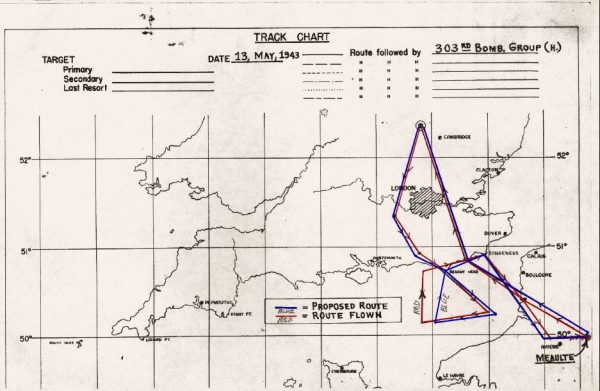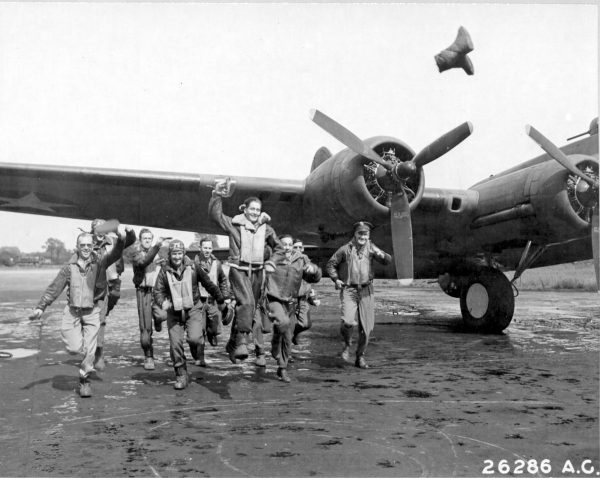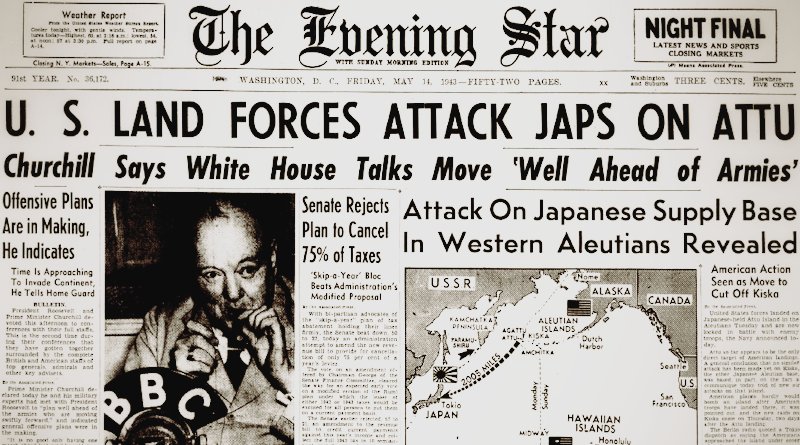World War II Chronicle: May 14, 1943
Click here for TODAY’S NEWSPAPER
The front page reports that American bombers staged the largest raid on Europe yet. Brig. Gen. Newton Longellow’s VIII Bomber Command had consisted of “The Four Horsemen” — the 91st, 303rd, 305th, and 306th Bomb Groups. But today the amount of bombers he can send over Axis targets has doubled: the 94th, 95th, 96th, and 351st Bomb Group are making their combat debut. The 305th is commanded by Col. Curtis LeMay, the future commanding general of Strategic Air Command.
Yesterday 97 B-17s crossed the channel to hammer the Avions Potez aircraft factory at Meaulte, France along with Luftwaffe airfields at St. Omer. The Forts have 124 P-47 Thunderbolts flying escort. The 303rd Bomb Group sent 21 B-17s out of RAF Molesworth to strike the factory with 10 500-lb. bombs each. All 21 returned.

Capt. Billy Southworth Jr., son of the St. Louis Cardinals manager, flew a B-17F named Son in the raid on Meaulte. Southworth began his minor league career with the Asheville Tourists, a club his dad managed. The Canadian-American League Baseball Writers’ Association named Southworth Jr. most valuable player in 1939, but he enlisted to become a pilot in 1940. The crew of Hell’s Angels (358th Bomb Squadron) won the race to 25 missions, beating out Memphis Belle of the 324th Squadron…

George Fielding Eliot column on page 16… Sports section begins on page 44. Both Southworths beat their opponents yesterday: the elder Southworth’s Redbirds beat the Boston Braves 5-0, with Ernie White pitching the shutout. This will be Ernie’s last season with St. Louis as he ships out for the Army next year and fights in the Battle of the Bulge. He reunites with Southworth, now with the Braves, in 1946.
Roving Reporter by Ernie Pyle
NORTHERN TUNISIA — Before the first day of the great surrender on the Bizerte-Tunis front was ever, I believe half the Americans in the area had German souvenirs of some sort.
There was very little of what one would call looting of German supply dumps. The Germans gave away helmets, goggles and map cases, which they will not be needing any more. The spoils of war which the average doughboy has on him are legitimate, and little enough recompense for his fighting.
Practically every American truck has a German or Italian helmet fastened to its radiator. Our motorcycles are decorated like a carnival, with French flags and the colorful little black-and-yellow death’s-head pennants the Germans use for marking their own mine fields.
Many soldiers have new Lugers in their holsters. Lots of our men clowningly wear German field caps. German goggles are frequently seen on American heads. I got in on the souvenirs too. I got one memento that is a little gem. It’s an automobile — yep, a real automobile that runs.
I drove back to camp that first evening in my German “Volks-wagon,” the bantam car the Nazis use as we use our jeep. It is a topless two-seater with a rear motor camouflaged a dirty brown.
Mine was given me by our First Armored Division for — as they said — “sweating it out with us at Faid Pass all winter.” As I drove back from the lines, Americans in the rear would stare, startled-like and belligerent; then, seeing an American at the wheel they would laugh and wave. I have owned half a dozen autos in my life, but I’ve never been so proud of one as of my clattering little Volkswagon.
On that first day of surrender the Germans sat in groups of hundreds in the fields, just waiting. They lay on their overcoats, resting. They took off their shirts to sun themselves. They took off their shoes to rest their feet.
They were a tired army but not a nondescript one. All were extremely well equipped. Their uniforms were good. They had plenty in the way of little personal things, money, cigarets, and food. Their equipment was of the best materials.
One English-appearing soldier had a Gem nail-clipper. He said he paid 25 cents for it in New York in 1939.
Some were cleanly shaven, some had three or four-day beards, just like our soldiers. Lots of them had red-rimmed eyes from lack of sleep.
As a whole, they seemed younger than our men, and I was surprised that on average they didn’t seem as big. But they did appear well fed and in excellent health.
They think Americans are fine fighters. They expressed only good-natured contempt for their allies, the Italians. As one of them said:
“It isn’t just that Italians don’t fight well. It’s simply that Germans don’t like Italians very much in the first place.”
Wherever any American correspondents stopped, prisoners immediately gathered around. They all seemed in good spirits. Even those who couldn’t speak a word of English would try hard to tell you something.
The main impression I got, seeing German prisoners, was that they were human like anybody else, fundamentally friendly, a little vain. Certainly not supermen. Whenever a group of them could form, some American soldier would pop up with a camera to get a souvenir picture. And every time all the prisoners in the vicinity would crowd into the picture like kids.
One German boy had found a broken armchair leaning against a barn, and was sitting in it. When I passed he grinned, pointed to his feet and then to the chair arms, and put his head in the international sign language for “Boy, does this chair feel good!”
This colossal German surrender has done more for American morale here than anything that could possibly have happened. Winning in battle is like winning at poker or catching lots of fish — it’s damned pleasant and it sets a man up. As a result the hundreds of thousands of Americans in North Africa now are happy men, laughing and working with new spirits that bubble.
Evening star. (Washington, D.C.), 14 May 1943. Chronicling America: Historic American Newspapers. Lib. of Congress.
https://chroniclingamerica.loc.gov/lccn/sn83045462/1943-05-14/ed-1/
